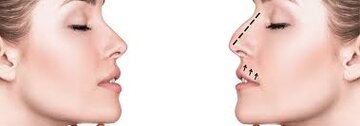Although nose job is the most popular plastic surgery in the world, it is associated with some risks and side effects, from breathing issues to skin irregularities. If you want to know whether this procedure is dangerous, read this article to the end.
Possible Complications of Rhinoplasty
Each patient has a specific medical history, and their body uniquely reacts to rhinoplasty, so the complications you face after this operation might differ from those of your friends or cousins. In the following, possible complications of rhinoplasty are mentioned briefly:
-
Allergic reaction to anesthetics, sutures, or antiseptic solutions;
-
Nausea, vomiting, dizziness, and headache;
-
Nosebleed and sore throat;
-
Nasal congestion;
-
Formation of a hematoma under the skin;
-
Numbness or hyper-sensation of the skin;
-
Numbness of upper front teeth;
-
Anosmia or partial loss of sense of smell;
-
Breathing problem;
-
The undesirable shape of the nose;
-
Prolonged swelling and bruising;
-
Septal perforation;
-
Skin necrosis;
-
Development of keloids and hypertrophic scars;
-
Damage to the nerves and blood vessels inside the nostrils;
-
Skin discoloration and hyperpigmentation.
What Factors Increase the Risk of Nose Job?
Generally speaking, your current medical condition significantly affects the result of your procedure. People who have a history of developing keloid scars, chronic infection, diabetes, blood coagulation disorders, high blood pressure, allergy to specific medications, and heart or lung problems are more prone to face serious complications of rhinoplasty. Also, a lack of essential vitamins such as K, C, D, and B and necessary minerals, including iron, zinc, and calcium, can interfere with the healing process and increase the risk of rhinoplasty. So, it would help if you got a full checkup (bloodwork and physical examination) before having rhinoplasty.
What Are the Risks of Rhinoplasty?
The risks of nose job surgery are mostly associated with the function of the nose, nasal skin, soft tissues, and grafts used in the operation. In the following, we discuss these risks in detail.
Risks associated with the function of the nose
Although one of the main aims of rhinoplasty is improving the function of the nose by opening up the nasal airways, in some cases, the patients complain about their breathing problems and excessive sinusitis discharges after the surgery. If the cause of the breathing issue is a blockage in the nose, the surgeon performs physical examinations to find the reason for this obstruction. In cases where the cause of congestion is a deviation of nasal bone or cartilage, a revision rhinoplasty can improve the situation. However, if the cause of congestion is the enlargement of inner vessels, the patient can only use saline sprays and serums to eliminate the swelling.
Risks associated with implants and grafts
Fortunately, the risk of infection, resorption, distortion, or extrusion of an artificial implant or a natural graft is less than 1%. In initial rhinoplasty, the surgeons usually use rib or ear cartilage to augment the nose. Still, in revision rhinoplasty, they mostly use silicone or polyethylene implants as they are more stable and have a lower rate of resorption and extrusion. Remember that most graft-related problems (except for infection) can be treated by injectable fillers and closed rhinoplasty, so you don't have to undergo an open-nose job to correct small deformities of your grafts and implants.
Risks associated with nasal skin
The main skin problems after nose job surgery are excessive swelling, bruising, numbness, seroma, fibrosis, necrosis, scarring, formation of cysts and keloids on the skin, and infection. A little swelling and temporary bruising are normal side effects of nose jobs, but if they worsen or persist for a long period, they can be considered a major risk. Luckily, most skin and soft tissue problems can be treated by surgery or other methods, such as laser therapy, radiotherapy, oral and topical medications, and injecting fillers. However, skin infection after a nose job can be life-threatening and must be treated immediately.
Infection after Nose Job Surgery
Infection is a rare complication of rhinoplasty, but if it is not treated on time, it can have irreversible health effects. The risk of nasal infection in initial rhinoplasty is less than 1%, but this number goes higher each time the operation is repeated. Also, in cases where the surgeon combines a nose job with sinus surgery, the risk of severe infection soars because millions of infectious bacteria live in the sinus mucous that can infect the whole nose structure. In this regard, the doctors usually prescribe antibiotics before and after the operation to minimize the risk of infection after nose job surgery.
Is Nose Job Surgery Dangerous in Iran?
Nose job surgery is associated with some risks and side effects; however, if you choose a qualified and skilled surgeon and follow the suggested post-op care carefully, the results of your surgery will be satisfactory, and you won't face dangerous complications from it. If you are searching for a safe and cheap place to get a nose job, Iran is your best choice. This country is the home to the most adept plastic surgeons in the world who offer you the best services at a very fair price. The cost of rhinoplasty in Iran, ranges from $1,400 to $2,700.
Why Choose Raadina Health for Having Rhinoplasty in Iran?
As one of the first-established tourism companies in Central Iran, Raadina Co. offers the most wholesome packages of cosmetic surgery, which cover various services at different prices. Foreign patients with different goals and budgets can benefit from the consultations and packages provided by the Raadina Health team. Therefore, if you are browsing for a full package of rhinoplasty in Iran, schedule a consultation with Raadina Health consultants and learn about the whole rhinoplasty process in Iran.


Your Comment